Drawn to Speed
By John Lander
214 pages Softcover
$40.00 USD
ISBN 978-0-7864-9875-0
McFarland 800-253-2187
www.mcfarlandpub.com
Also available as an ebook at www.mcfarlandpub.com/customer/ebooks
Review by Pete Vack
A package arrived in the mail; the return address indicated it is from McFarland Publishing, always a good sign as they are responsible for putting in print Carl Goodwin’s They Started in MGs and Put in Bay not to mention Elsa Nystrom’s Mad for Speed.
A package, then to be taken seriously.
Inside, a small book that got my attention right off the mark. For on the cover of “Drawn to Speed, The Automotive Art of John Lander,” is a painting of a Squire, and a foreword by none other than Larry Crane. I was not familiar with Lander or his art, but the Squire depicted is a car as owned by Charles Davison, now residing at the Simeone Foundation. Charles Davison was the father of VeloceToday contributor Eric Davison. Years ago, Eric wrote a touching memoir of his father’s Squire for us.. I emailed Davison, an east coaster who now lives in Florida, to see if he knew Lander. Nope. He would soon, I told him.
Of course Crane knew Lander. Crane, bless his heart, once contributed a very popular monthly column to VeloceToday and we do miss his entertaining articles. Crane had already published some of Lander’s work in several magazines including Automobile and it was Larry who suggested to Lander that he publish a book of his art. “I…am always intrigued by his depth of knowledge of automotive history, but more in admiration of his ability to include the important personalities in a specific moment in time – a rare gift,” wrote Crane in the Foreword.
Crane is also a talented artist and was one of the first to recognize Lander’s unique ability to not only portray the subject, along with people, but write brief, accurate and insightful commentary to accompany the images. And that’s what Lander’s art -and his book – is all about.
Son of an Atlanta Dodge dealer, by the age of 16 in 1951, John was smitten with the post war sports car craze and his first car was an MG TC instead of a Dodge, much to his father’s dismay. He then went to California, spending a year at the Art Center School in LA. He continued his art education but soon realized that the phrase ‘starving artist’ had a basis in reality. He joined his father’s dealership and worked in the car industry until 1972, when he found a good paying job as a designer and project manager in Atlanta. But all along the way, he owned a long list of interesting sports cars and continued to improve his painting as well as doing the research that led to a more introspective work of art. Now retired, he is well known among the art crowd and is now selling his framed art to collectors.
Lander arranged the book by subject matter or topic, the first being Racing Cars, then The French Connection, California Dreaming and so on. In most cases, the art is on the right facing page and text on the left. Below, a selection of his art with comments.
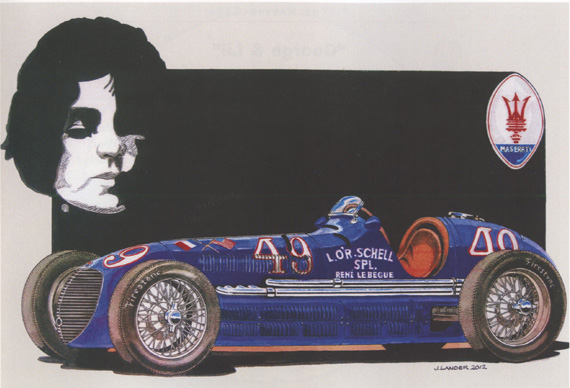
The first section is entitled “The Racing Cars” and the first selection, happily, is one of the two Schell 8CTF Maseratis shipped to Indy by Lucy O’Reilly Schell in 1940. Lander adds a somewhat mysterious woman in painting and does not provide any details. However, a quick Google search found a rare and very early photo of Lucy O’Reilly which obviously was the basis for Lander’s insert. Lucy is also the mother of Grand Prix driver Harry Schell, born in 1921.
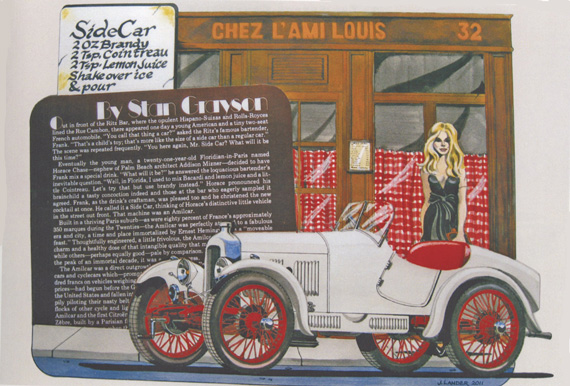
Another section illustrates French cars of interest. Lander explains that “Sidecar” is a drink named by a famous French bartender. Where the Amilcar comes in is a good story and also related in the painting by Stan Grayson. The story is as delightful as the Amilcar and Lander’s art. (Grayson wrote about the Amilcar in V13-1 of Automobile Quarterly.)
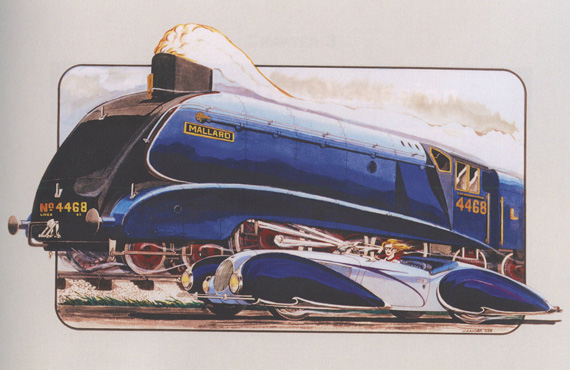
This Talbot Lago and a British locomotive named the Mallard never were in close proximity, writes Lander, but for this painting he imagined that in 1938 the young lady in the Figoni et Falaschi Talbot T150C SS challenges the conductors of the Mallard as they hurtle along, side by side. In actually, races between cars, bikes and trains were not uncommon in the 1930s, as if the automobile was trying to defeat the train as the master of transportation.

Lander included a segment devoted to “American Iron”. We found this portrait of a Derham-bodied Cadillac enchanting. The owner of the actual car had approached Lander’s vending stand at a car meet and commissioned him to paint his prize possession. According to Lander, the owner hadn’t been able to find an artist who combined both people and cars to his satisfaction. The resulting painting was a showcase of Lander’s abilities.
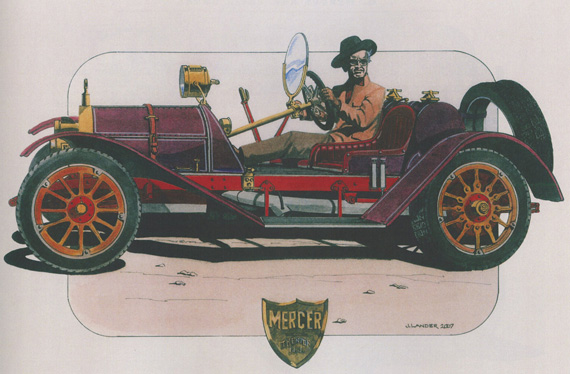
Having immersed himself into the postwar foreign car revolution, Lander was very aware of the talents and influence of Ken Purdy. He paid tribute to Ken’s never ending enthusiasm by portraying Purdy behind the wheel of his beloved Mercer Raceabout. Ken is obviously pleased to be behind the wheel of one of the very last Mercer’s to be discovered after WWII.
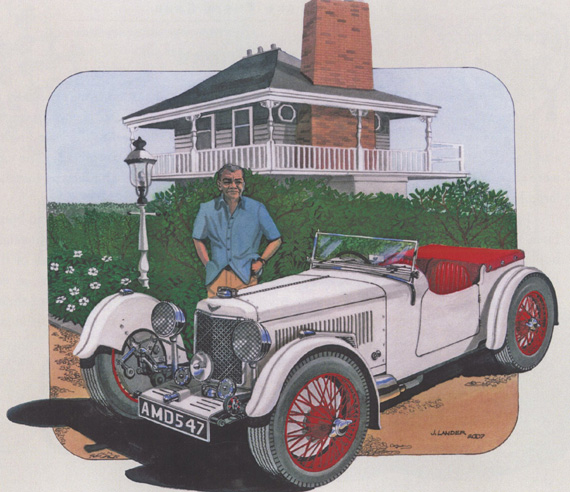
Another illustration in the sections “Heroes and Their Cars” put cartoonist Charles Addams in front of his home in Westhampton Long Island. The car is his 1933 Aston Martin Le Mans. Lander met Addams in 1980s, and eventually signed Lander’s collection of Addams’ cartoon books. Addams owned many interesting cars over the years, and his Alfa 2300 is still in original condition at the Simeone Foundation.
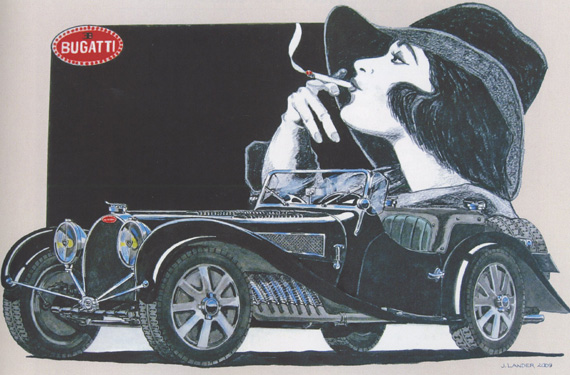
“Ettore Bugatti created wonderful, beautiful automobiles. God created wonderful, beautiful women,” writes Lander in the introduction of a series of paintings that combine women and Bugattis. Perhaps the most evocative is this rebodied Type 54 Grand Prix now in the Mullin Museum collection where Lander saw it in 2012.
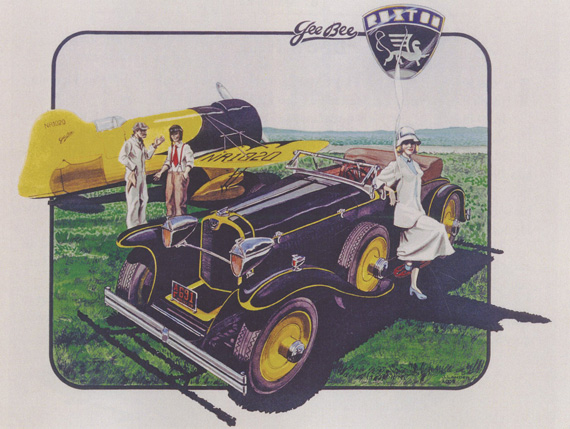
One of our favorites, as Lander pulls together the theme of airplanes and automobiles with an artistic flair that captures the style and excitement of the early 1930s (although Lander titles the piece “Just Plane Bored”). The Bee Gee won the 1932 Thompson Trophy race piloted by Jimmy Doolittle, while the 1930 Ruxton exemplified the advanced technology of the era, with a low profile, front wheel drive and streamlined Woodlite headlights.
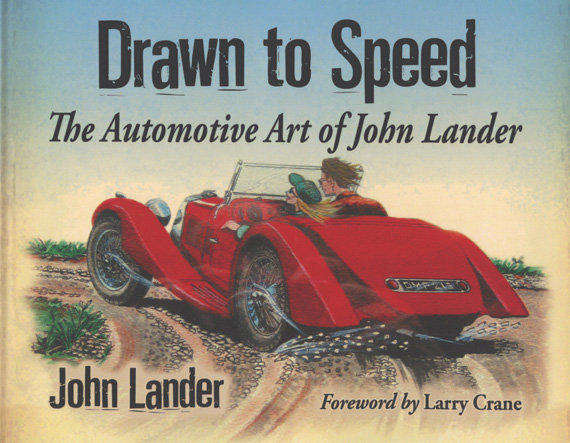
~ Outstanding artwork, great article. Thanks — SC
Not only is the artwork wonderful, but the knowledge of all of the cars that John illustrates is fascinating. He remembers details of the cars, owners, and other facts that most of would never acknowledge. The only thing better than having one of these books, is actually having a picture from John. I love my print of the 1920 Mercer gifted to me from John Lander himself.
Rosemarie Ward
Lander’s illustrations are charming and nostalgic. Thanks for reviewing his book and for bringing it to my attention
Pete,
Thanks for this item.
I met John when I was one of the editors of the now-defunct Car Collector magazine in the late ’70s-early ’80s. As I recall he did a few illustrations for us. But I had lost contact with John and after seeing this, tracked him down to renew our dormant friendship. In fact, I just got off the phone with him.
Ordered a copy of the book, as well. and am planning to get together with him soon so he can sign it.
My wife is editor of the Morgan newsletter, “Morganotes”. Is there any thing in the book “Drawn to Speed” that we could use in the newsletter?
John